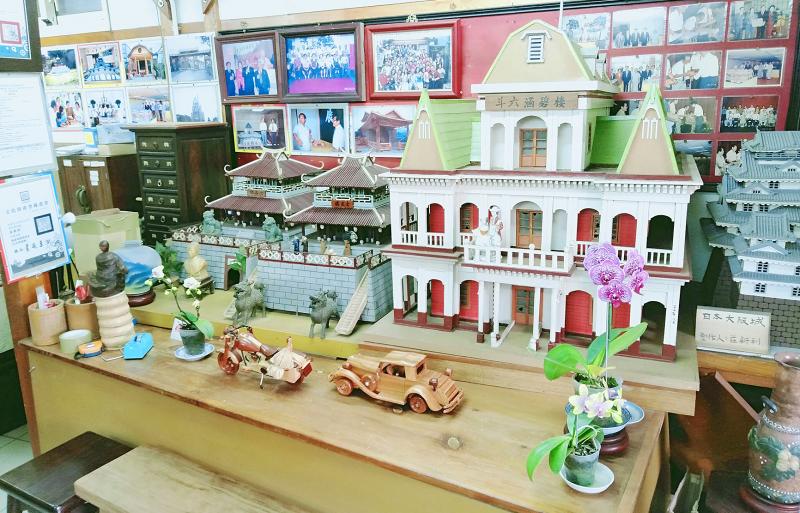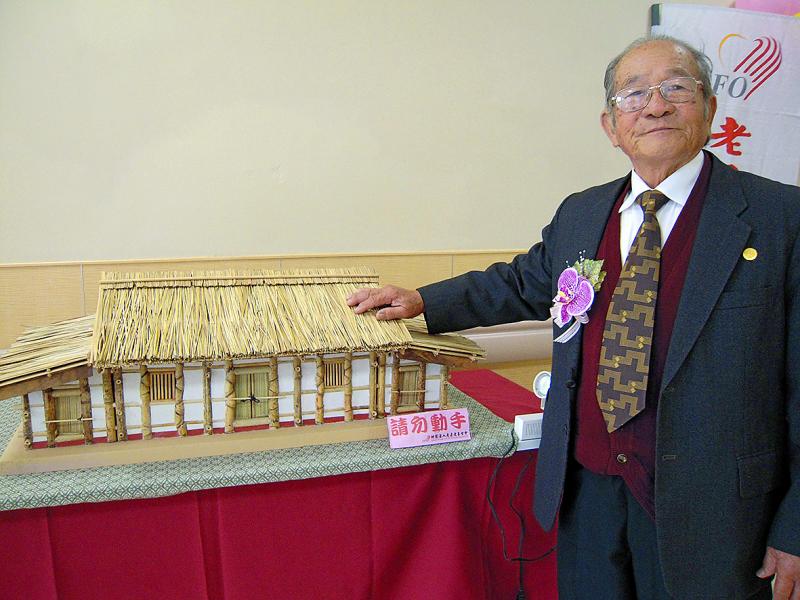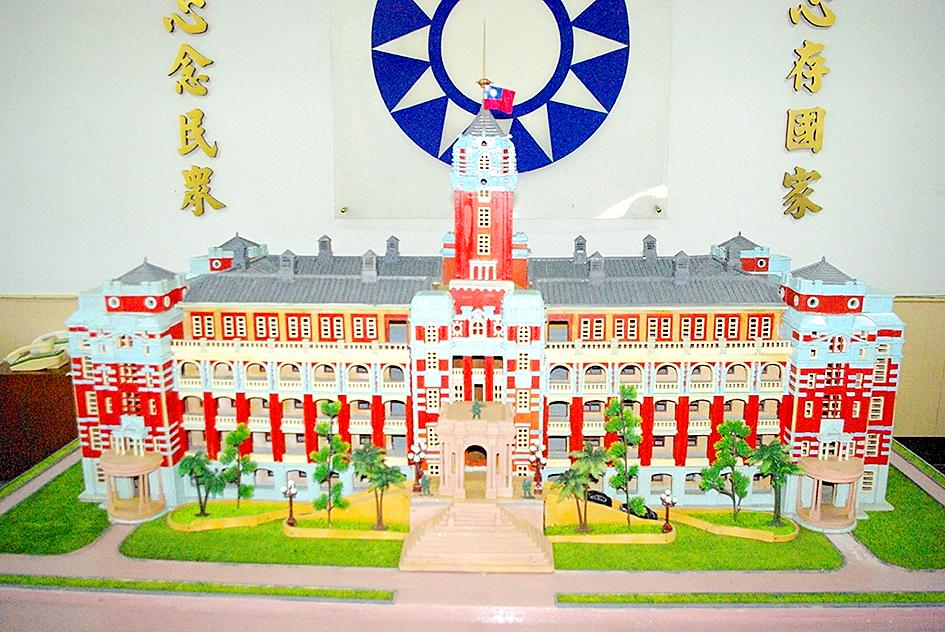But for a banana, I wouldn’t have met Chuang Hsin-li (莊新利).
En route to the mountains of Yunlin County, I stop for sustenance at a fruit truck in Gukeng Township (古坑). It’s the second day of Lunar New Year; the vehicle is sparsely stocked: sprigs of lycees and bunches of bananas from one of which the vendor snips my breakfast. At the cab-end of the cargo bed, a box of oranges is guarded by pint-sized pineapples festooned with red ribbons. The mauve-tinged leaves of hungry winter pineapples occupy acres of farmland here, but the type on the truck, which is referred to as a “pineapple bouquet,” (鳳梨花) is strictly ornamental.
As the word for “pineapple” in Taiwanese is homophonic with a summons to prosperity, pineapple products are popular during the Lunar New Year. The bouquet variety are particularly auspicious and found at temples and household altars island wide. “Their long tails are really lucky,” says the vendor, stroking the spiky mohawk of one fruit.

Photo: James Baron
Accompanied by advice, my banana proves blessing enough.
“Turn left at the traffic lights, then right at the end of the next road,” says the vendor on learning that I’m heading for the hills. “It’s quicker.”
Just before the second turn, I spot a strange collection of buildings on the corner of a lane.

Photo: Hsu Hsia-lian, Taipei Times
Two cabins flank a central single-story construction, conspicuous for its karahafu, an undulating gable found in Japanese architecture. The facade sports a circular plaque featuring a wood-carved relief of flowers entwined with the elongated tail feathers of two songbirds.
Similar motifs line the wall of the cabin to the right. On the front wall, a poster features an image of Taiwan’s Presidential Office Building and the face of an elderly man beneath the stylized Chinese characters for “ingenuity” (匠心). The same word can be seen to the side of the main building on a placard that displays a biography: Chuang Hsin-li; born in 1933; began a year’s apprenticeship as a builder under his father at 17 years old …
Before I get any further, the face from the poster appears at the glass doors, which slide open. “Come in for a look?”

Photo: Chan Shih-hung, Taipei Times
MINIATURE MASTERPIECES
The interior — a small studio — is a picture of orderly clutter. Framed photos, awards and ornaments occupy wall and worktop space, assorted bric-a-brac almost every corner. On the desk nearest the entrance, a hefty magnifying glass sits between a bag of peanuts and a transistor radio blaring the morning news.
Pride of place belongs to a collection of miniature architectural masterpieces. Most replicate Taiwanese historical sites: the blue-tiled Gate of Great Piety (大孝門) from Chiang Kai-shek Memorial Hall, Changhua Confucius Temple (彰化孔子廟) and Tainan’s Chikan Tower (赤嵌樓), the old Dutch Fort Provintia. Sandwiched between this and a copy of Osaka Castle is an unfamiliar structure.
“That’s the Hanbi Building (涵碧樓),” said Master Chuang, as he is respectfully known. “That got knocked down in … it must have been 1988.”
One of Taiwan’s largest residences during its heyday, this four-story “Spanish-style” villa belonged to Chen Lin Shi-bao (陳林氏寶), a fascinating figure who was among the richest merchants of the Japanese colonial era. Master Chuang was spot on with the year: following its conversion into a restaurant in the late 1970s, the building was demolished when the Chen family found the tax burden too onerous.
PRESERVING THE PAST
Today, mention of the Hanbi Building often draws blank looks. A 30-something acquaintance who grew up in Yunlin found the name vaguely familiar. “Is that in China?” she asked.
“That’s why I want to preserve this history,” Master Chuang explained. “This was an important building.”
This quest to memorialize architectural heritage — extant and vanished — was the impetus for Chuang’s unplanned foray into model-making. A jack-of-all-trades — “I was a builder, a carpenter … a bit of everything” — Chuang found himself uninspired by his late 50s. That’s when he began putting the knowledge and skills he had acquired to alternative use.
One of his first works was a replica of Gukeng’s Japanese-era township and farmer’s association office, a building he had worked on as a young man. First-hand knowledge of the structure and materials allowed Chuang to recreate this now long-gone building. A version of Chuang’s model now sits in the current township office, on the site of its predecessor.
A similar position is occupied by his masterpiece — the miniature Presidential Office building, which was presented to Ma Ying-jeou’s (馬英九) administration. While most of Chuang’s cypress-wood sculptures were completed within several months, Chuang says this piece took longer because of restrictions on photographing features of the building, including the interior.
NEVER ALONE
Chuang’s fastidious attention to detail means he is not content to just recreate the outward appearance of the constructions. “The inside is just as important,” he says, highlighting his painstaking efforts to imitate the structural elements. “So is function,” he adds, illustrating this through the mechanics of a model drawbridge in a far corner of the studio.
As he leads me back outside to my bike, we take a quick look inside the cabin, which contains other models, including a rendering of Beijing’s multi-tiered Temple of Heaven. Several more woodcarvings with auspicious characters line the walls. The lights are off and, in the dim, misty morning light, the little room seems forlorn, its prefab build conveying a transitoriness that undermines the permanence Chuang aimed to achieve in his work.
Master Chuang has just returned from a Lunar New Year’s dinner with family in Douliu the previous day. Back at his workshop where he spends his days reading, listening to the radio, and taking neighborhood strolls, Chuang sleeps on a rollout bed surrounded by his creations.
Though sprightly for his age, failing eyesight put an end to his handiwork several years ago. Does he never get bored or lonely? “No,” he says. “I have all these to keep me company.”
Back on the road up to the mountains, the pineapple fields resume. But it’s the banana and the chance meeting it led to that will linger longest in my mind.

Sept.16 to Sept. 22 The “anti-communist train” with then-president Chiang Kai-shek’s (蔣介石) face plastered on the engine puffed along the “sugar railway” (糖業鐵路) in May 1955, drawing enthusiastic crowds at 103 stops covering nearly 1,200km. An estimated 1.58 million spectators were treated to propaganda films, plays and received free sugar products. By this time, the state-run Taiwan Sugar Corporation (台糖, Taisugar) had managed to connect the previously separate east-west lines established by Japanese-era sugar factories, allowing the anti-communist train to travel easily from Taichung to Pingtung’s Donggang Township (東港). Last Sunday’s feature (Taiwan in Time: The sugar express) covered the inauguration of the

The corruption cases surrounding former Taipei Mayor and Taiwan People’s Party (TPP) head Ko Wen-je (柯文哲) are just one item in the endless cycle of noise and fuss obscuring Taiwan’s deep and urgent structural and social problems. Even the case itself, as James Baron observed in an excellent piece at the Diplomat last week, is only one manifestation of the greater problem of deep-rooted corruption in land development. Last week the government announced a program to permit 25,000 foreign university students, primarily from the Philippines, Indonesia and Malaysia, to work in Taiwan after graduation for 2-4 years. That number is a

In a stark demonstration of how award-winning breakthroughs can come from the most unlikely directions, researchers have won an Ig Nobel prize for discovering that mammals can breathe through their anuses. After a series of tests on mice, rats and pigs, Japanese scientists found the animals absorb oxygen delivered through the rectum, work that underpins a clinical trial to see whether the procedure can treat respiratory failure. The team is among 10 recognized in this year’s Ig Nobel awards (see below for more), the irreverent accolades given for achievements that “first make people laugh, and then make them think.” They are not

This Qing Dynasty trail takes hikers from renowned hot springs in the East Rift Valley, up to the top of the Coastal Mountain Range, and down to the Pacific Short vacations to eastern Taiwan often require choosing between the Rift Valley with its pineapple fields, rice paddies and broader range of amenities, or the less populated coastal route for its ocean scenery. For those who can’t decide, why not try both? The Antong Traversing Trail (安通越嶺道) provides just such an opportunity. Built 149 years ago, the trail linked up these two formerly isolated parts of the island by crossing over the Coastal Mountain Range. After decades of serving as a convenient path for local Amis, Han settlers, missionaries and smugglers, the trail fell into disuse once modern roadways were built